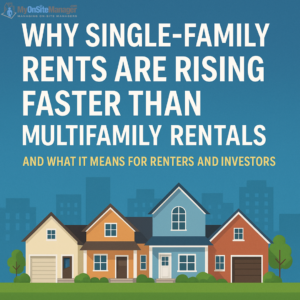The U.S. housing market has experienced significant shifts in rental trends over the past few years, with single-family rental prices increasing at a much faster rate than those of multifamily apartments. This divergence is reshaping the rental landscape, affecting tenants, landlords, and real estate investors alike.
Single-Family vs. Multifamily Rent Growth: The Data
Recent data from Zillow highlights this growing gap. As of December 2024:
- The median asking rent for single-family homes reached $2,174 per month, reflecting a 4.4% year-over-year increase and an astonishing 40.6% surge since the start of the COVID-19 pandemic.
- In comparison, multifamily apartment rents averaged $1,812 per month, increasing by only 2.4% year-over-year and 26.2% since pre-pandemic levels.
- As a result, single-family rentals are now 20% more expensive than multifamily units—a record-high premium.
This trend is particularly evident in suburban and Sun Belt markets, where rental demand for single-family homes has surged.
What’s Driving the Growth in Single-Family Rents?
The rapid increase in single-family rental prices is the result of several interrelated factors, including changes in consumer behavior, supply limitations, and economic conditions.
1. Changing Preferences: Space and Privacy Are Now Priorities
During the pandemic, many people reassessed their living arrangements, leading to increased demand for single-family rentals. Key drivers of this shift include:
- Remote Work & Home Offices: With hybrid and fully remote work arrangements becoming more common, tenants are seeking extra space for home offices.
- Outdoor Areas & Privacy: Renters are prioritizing private yards, driveways, and personal space over shared amenities like apartment gyms and pools.
- Family-Friendly Living: Many families, especially those with children, prefer the flexibility and stability of single-family homes, which often come with access to better school districts.
2. Supply Constraints: Limited Inventory of Single-Family Rentals
While demand for single-family rentals has soared, supply has struggled to keep up. Several challenges contribute to this:
- Low Housing Construction Rates: Developers have prioritized multifamily construction due to lower costs and zoning advantages.
- Zoning Restrictions: Many cities limit the construction of new single-family rental communities, further tightening supply.
- Conversion of Homes into Short-Term Rentals: A growing number of single-family homes are being converted into Airbnb-style short-term rentals, reducing the available long-term rental stock.
3. Affordability Crisis: Homeownership is Out of Reach for Many
High mortgage rates and soaring home prices have made buying a home financially impossible for many Americans, forcing more people into the rental market.
- Mortgage Rates Are Historically High: With rates hovering around 7%, many first-time buyers are delaying home purchases.
- Housing Prices Continue to Rise: Home values remain elevated, requiring larger down payments and higher monthly mortgage costs.
- Renting is (Still) Cheaper Than Owning: In many markets, renting a single-family home is 30% cheaper than purchasing the same home with a mortgage.
4. Institutional Investors and Wall Street’s Role
Institutional investors and real estate investment trusts (REITs) have significantly increased their presence in the single-family rental market. These large-scale investors buy up homes, renovate them, and lease them at premium rates, further driving up prices.
- Investor-Owned Single-Family Homes: Firms like Invitation Homes and American Homes 4 Rent own and manage thousands of single-family rental properties nationwide.
- Higher Rent Expectations: Institutional investors often price rents higher than traditional mom-and-pop landlords to maximize returns.
What Does This Mean for Renters?
For tenants, the growing price gap between single-family and multifamily rentals presents both challenges and choices:
1. Affordability Challenges
- Many middle-income renters are being priced out of single-family homes and turning to townhomes, duplexes, or larger apartments as alternatives.
- Suburban and exurban rental markets are becoming less affordable, forcing renters to look at lower-cost cities or rural areas.
2. Increased Competition for Rentals
- With more people unable to afford homeownership, demand for rentals remains strong, leading to bidding wars on available single-family properties.
- Renters may need to move quickly and offer higher deposits to secure desirable homes.
3. Multifamily Units Are a More Affordable Option
- Apartments continue to provide a more budget-friendly alternative for renters who don’t require extra space or privacy.
- Some luxury multifamily developments offer high-end amenities, making them competitive with single-family rentals.
Opportunities for Investors and Landlords
Despite affordability concerns, the rising demand for single-family rentals presents several investment opportunities:
1. Build-to-Rent (BTR) Communities Are Growing
- Developers are increasingly building entire neighborhoods of single-family rental homes, specifically designed for long-term tenants.
- These communities offer amenities such as property management, security, and shared recreational spaces.
2. Converting Homes into Rentals Can Yield High Returns
- Homeowners struggling to sell their properties due to high interest rates may choose to rent them out instead.
- Short-term rentals are lucrative in vacation hotspots but may be subject to new regulations in certain cities.
3. Suburban Markets Will Continue to See High Demand
- Investors looking for steady rental income should focus on suburban areas with strong job growth and good schools.
Final Thoughts: What’s Next for the Rental Market?
The gap between single-family and multifamily rental prices is expected to persist, as demand for larger living spaces remains strong. While affordability remains a key concern, creative solutions such as build-to-rent communities, zoning reforms, and new housing incentives may help balance the market over time.
For renters, flexibility will be essential—those seeking affordability may need to consider apartments, while those prioritizing space may need to adjust their budget or location preferences. Investors, meanwhile, will find continued opportunities in high-demand rental markets.
As the housing landscape evolves, staying informed about rental trends and economic factors will be crucial for both tenants and landlords alike.

